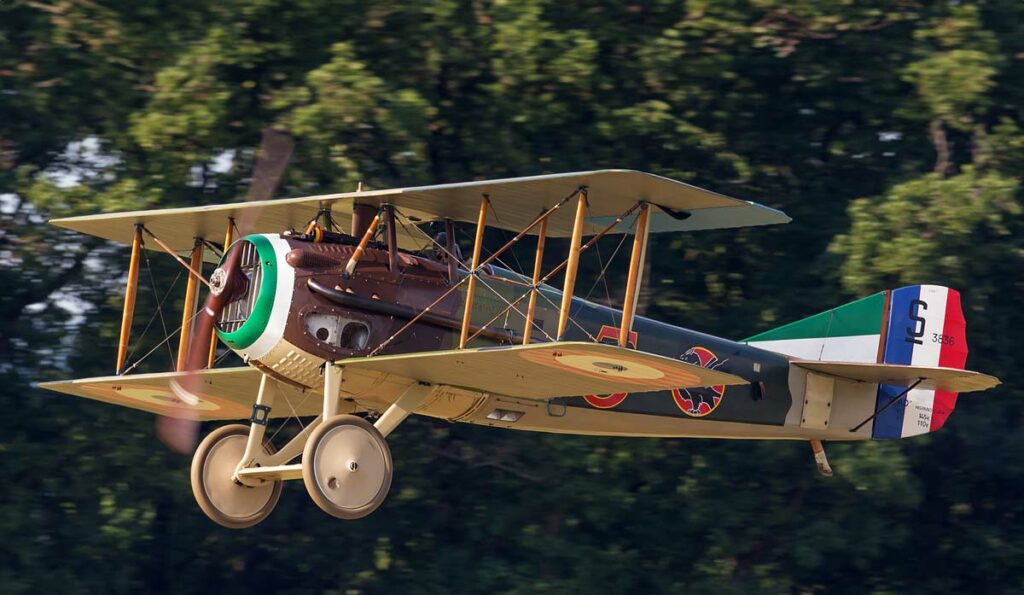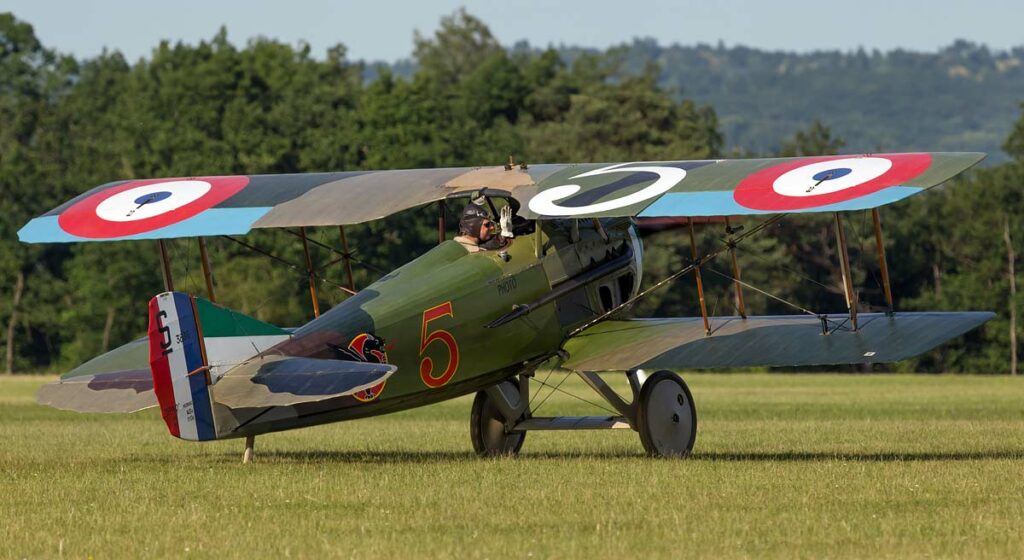The SPAD S.XIII, a French biplane fighter, excelled in WWI with its robust construction, Hispano-Suiza engine, and dual Vickers machine guns. This article delves into the SPAD S.XIII, covering its development, design, performance, and military use during WWI. It highlights the aircraft’s impact on aerial combat and its legacy.
The SPAD S.XIII, a French biplane fighter aircraft, played a pivotal role in aerial combat during World War I. Renowned for its speed and durability, it was one of the most effective fighters of its time.

History of the Development of the SPAD S.XIII
The Era’s Background
During WWI, rapid advancements in aviation technology led to an arms race in the skies. The need for superior air power was crucial for reconnaissance, air superiority, and tactical support.
Need for the Aircraft
The SPAD S.XIII was developed in response to the evolving requirements of aerial warfare. The demand was for a faster, more powerful fighter to counter formidable German aircraft like the Albatros and Fokker series.
Development Objectives
The primary goal was to create a robust, high-performing fighter with improved speed, armament, and reliability over its predecessors, particularly the SPAD S.VII.
Program Inception
The program was initiated by the Société Pour L’Aviation et ses Dérivés (SPAD), under the guidance of chief designer Louis Béchereau.
Maiden Flight
The SPAD S.XIII first took to the skies in April 1917, showcasing its potential as a front-line fighter.
Design of the SPAD S.XIII
Structural Details
- Length: 6.25 m (20 ft 6 in)
- Wingspan: 8.25 m (27 ft 1 in)
- Height: 2.35 m (7 ft 9 in)
- Wing Area: 21.1 m² (227 ft²) Powerplant
- Engine: Hispano-Suiza 8Be, 8-cylinder V-type, water-cooled
- Power: 220 hp (164 kW) Design Advantages
The aircraft’s robust construction allowed it to withstand significant battle damage. The streamlined fuselage and improved aerofoil enhanced aerodynamics, contributing to its agility and speed. Limitations
The SPAD S.XIII faced issues with its heavy controls, making it less maneuverable than some of its contemporaries. The engine was also prone to overheating and required careful management. Contributions to Aviation
The design of the SPAD S.XIII influenced subsequent fighter aircraft, particularly in its combination of firepower, speed, and structural integrity.
Performance of the SPAD S.XIII
Engine Performance
The Hispano-Suiza engine was a significant upgrade, providing enhanced power and reliability, crucial for combat effectiveness.
Speed, Altitude, and Range
Maximum Speed: 218 km/h (135 mph)
Service Ceiling: 6,650 m (21,815 ft)
Range: 480 km (298 miles) Comparative Analysis
When compared to its rivals like the Albatros D.V and the Fokker Dr.I, the SPAD S.XIII had a clear advantage in speed and altitude performance. It was, however, slightly less agile in dogfights. Military Use and Combat of the SPAD S.XIII Armament
The aircraft was equipped with two synchronized Vickers machine guns, providing substantial firepower.

Combat Service
The SPAD S.XIII played a crucial role in World War I, particularly on the fiercely contested Western Front. This front was the scene of some of the most intense and significant aerial combat of the war, where air superiority was not just an advantage but a necessity for survival and tactical success.
Engagement and Defeat of German Fighters
The SPAD S.XIII was particularly valued for its capability to engage effectively with German fighters, which were among the best in the world at the time. German aircraft like the Albatros D.V, Fokker Dr.I, and the Pfalz D.III were formidable opponents, known for their agility and effective armament. The SPAD’s superior speed and climb rate, coupled with its robust construction and powerful armament, gave it an edge in these encounters. It could pursue German fighters at higher altitudes and engage them in dogfights with a significant chance of success.
Key Battles and Operations
During its service, the SPAD S.XIII was involved in numerous key battles and operations over the Western Front. These included:
- Air Superiority Missions: The SPAD S.XIII squadrons were frequently tasked with gaining and maintaining air superiority over the battlefields. This involved engaging in dogfights, disrupting German reconnaissance and bombing missions, and protecting Allied bombers and reconnaissance aircraft.
- Escort Duties: Allied bombing raids and reconnaissance missions over German lines were critical for gathering intelligence and disrupting enemy operations. SPAD S.XIIIs often escorted these missions, warding off German fighter attacks.
- Ground Attack Roles: Although primarily designed as a fighter, the SPAD S.XIII was also occasionally used in ground-attack roles. Its armament was effective against ground targets, and its speed allowed it to make quick strikes against enemy positions.
- Tactical Support: The aircraft also played a role in supporting ground troops by harassing enemy troop concentrations, attacking supply lines, and conducting low-level bombing runs. Operational Challenges and Successes
While the SPAD S.XIII was a highly effective fighter, its operational use was not without challenges. Pilots often mentioned the physical strain of flying the aircraft due to its heavy controls, especially during prolonged engagements. Additionally, engine overheating was a common issue. Despite these challenges, the successes of the SPAD S.XIII far outweighed its limitations. Its robustness often allowed pilots to return safely from missions even when the aircraft had sustained significant damage.
Legacy of the SPAD S.XIII in Aerial Combat
The SPAD S.XIII’s success on the Western Front cemented its reputation as one of the most effective fighters of World War I. It significantly contributed to the Allied air superiority during the later stages of the war. The experiences gained from its operational use informed the development of subsequent fighter aircraft, and its impact on aerial warfare tactics and strategy was profound. The aircraft’s combination of speed, firepower, and ruggedness set new standards for fighter design in the years to follow.
Competing Aircraft
Its main adversaries included the Albatros D.V, Fokker Dr.I, and the Pfalz D.III.
International Service and Legacy
The SPAD S.XIII was used by several allied nations and proved to be a highly successful export. It was eventually replaced by more advanced aircraft in the post-war years.
The SPAD S.XIII’s contribution to World War I aviation was significant. With its formidable combination of speed, durability, and firepower, it not only dominated the skies during its time but also set a benchmark for future fighter aircraft designs.
Back to the Warbirds section.